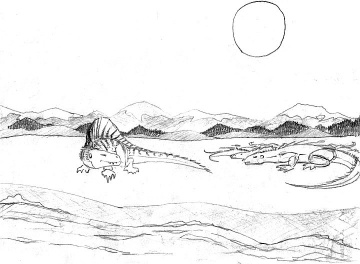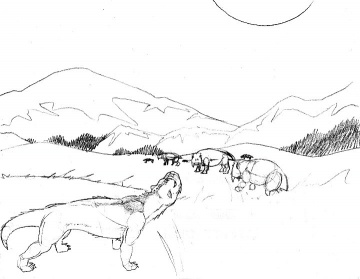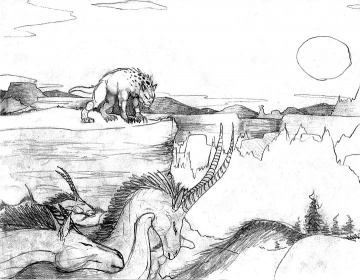Difference between revisions of "Dinosaurs and Prehistoric Animals"
(→Jurassic Period) |
(rv vandalism, several layers worth) |
||
| Line 30: | Line 30: | ||
* [[Dinosaurs and Prehistoric Animals:Laurasia 210 Million Years Ago|Laurasia 210 Million Years Ago]] (archosaurs, early dinosaurs, Placerias) | * [[Dinosaurs and Prehistoric Animals:Laurasia 210 Million Years Ago|Laurasia 210 Million Years Ago]] (archosaurs, early dinosaurs, Placerias) | ||
| − | + | ===Jurassic Period=== | |
| + | |||
| + | ''Giant Dinosaurs and Sea Monsters'' | ||
| + | |||
| + | The Jurassic is the middle and perhaps most iconic period of the Mesozoic era. Huge theropod dinosaurs like Allosaurus preyed on even more gigantic sauropod dinosaurs like Diploducus and better armored dinosaurs like Stegosaurus. In the sea pliosaurs such as Liopleurodon preyed on Ichthyosaurus and plesiosaurs like Cryptoclidus. | ||
| + | |||
| + | * [[Dinosaurs and Prehistoric Animals:North America 190 Million Years Ago|North America 190 Million Years Ago]] (Massospondylus, Dilophosaurus, Scelidosaurus, Scutellosaurus) | ||
| + | * [[Dinosaurs and Prehistoric Animals:The Islands of Europe 165 Million Years Ago|The Islands of Europe 165 Million Years Ago]] (Ichthyosaurus, Metriorhynchus, Liopleurodon, Cryptoclidus, island dinosaurs) | ||
| + | * [[Dinosaurs and Prehistoric Animals:North America 150 Million Years Ago|North America 150 Million Years Ago]] (Allosaurus, Ceratosaurus, Stegosaurus, famous sauropods, etc.) | ||
===Early Cretaceous Period=== | ===Early Cretaceous Period=== | ||
| Line 39: | Line 47: | ||
* [[Dinosaurs and Prehistoric Animals:North America 120 Million Years Ago|North America 120 Million Years Ago]] (Acrocanthosaurus, Utahraptor, Deinonychus, ankylosaurs, Astrodon, Tenontosaurus) | * [[Dinosaurs and Prehistoric Animals:North America 120 Million Years Ago|North America 120 Million Years Ago]] (Acrocanthosaurus, Utahraptor, Deinonychus, ankylosaurs, Astrodon, Tenontosaurus) | ||
| − | + | ===Late Cretaceous Period=== | |
| + | |||
| + | ''Tyrannosaurs and Sea Serpents'' | ||
| + | |||
| + | The late Cretaceous of North America is the most iconic scenario of the Cretaceous (only lacking sauropods and Stegosaurus.) Mosasaurs (sea serpents) replace pliosaurs in the late Cretaceous seas. Birds are the only dinosaurs to survive beyond the end of the Cretaceous. (The giant sea reptiles, pterosaurs and many other types of land and sea creatures went extinct at that time.) | ||
| + | |||
| + | * [[Dinosaurs and Prehistoric Animals:Mongolia 80 Million Years Ago|Mongolia 80 Million Years Ago]] (oviraptors, therizinosaurs, ornithomimids, Tsintaosaurus, Protoceratops, Tarbosaurus) | ||
| + | * [[Dinosaurs and Prehistoric Animals:North America 80 Million Years Ago|North America 80 Million Years Ago]] (tyrannosaurs, ceratopsians, hadrosaurs, ankylosaurs, pachycephalosaurs, ornithomimids, etc.) | ||
| + | * [[Dinosaurs and Prehistoric Animals:The Western Interior Seaway 80 Million Years Ago|The Western Interior Seaway 80 Million Years Ago]] (mosasaurs, Elasmosaurus, Archelon, marine birds and pterosaurs) | ||
===Eocene Epoch=== | ===Eocene Epoch=== | ||
| Line 57: | Line 73: | ||
* [[Dinosaurs and Prehistoric Animals:Australia 8 Million Years Ago|Australia 8 Million Years Ago]] (flightless carnivorous ducks, land crocodiles, big marsupials) | * [[Dinosaurs and Prehistoric Animals:Australia 8 Million Years Ago|Australia 8 Million Years Ago]] (flightless carnivorous ducks, land crocodiles, big marsupials) | ||
| − | + | ===Miocene-Pliocene boundary=== | |
| + | |||
| + | * [[Dinosaurs and Prehistoric Animals:Megalodon's Seas|Megalodon's Seas]] 5 Million Years Ago (Megalodon, Eurhinodelphis, Dorudon) | ||
| + | |||
| + | [[Image:Mammal-predator.jpg|360px|right]] | ||
| + | ===Pleistocene=== | ||
| + | |||
| + | This recent cold period is sometimes called the Ice Age. Modern animals lived in most parts of the world, and many creatures moved back and forth between the contents of Africa, Europe, Asia, North and South America. Isolated Australia continued to have a unique fauna that included giant predatory birds and reptiles. | ||
| − | + | * [[Dinosaurs and Prehistoric Animals:Pleistocene Australia|Pleistocene Australia]] (Genyornis, Megalania, Thylacoleo, Diprotodon, Procoptodon) | |
| + | * [[Dinosaurs and Prehistoric Animals:Eurasia 100 Thousand Years Ago|Eurasia 100 Thousand Years Ago]] (big cats, Cave Bear, Irish Elk, Elasmotherium, Woolly Rhino, Mammoth, homonids, Gigantopithecus) | ||
| + | * [[Dinosaurs and Prehistoric Animals:Ice Age California|Ice Age California]] (Teratornis, Aiolornis, big cats, Arctodus, Giant Bison, Mammoth) | ||
| + | * [[Dinosaurs and Prehistoric Animals:Pleistocene South America|Pleistocene South America]] (Smilodon, Megatherium, Mastodon, glyptodonts, Toxodon, Macrauchenia, Xenorhinotherium) | ||
Revision as of 09:06, 24 October 2012
This sourcebook contains information about dinosaurs and other prehistoric animals for role-playing games. This information can be used for dinosaurs and other prehistoric animals cloned by mad scientists, encountered by time travelers, surviving in lost worlds or as monsters in fantasy worlds.
Contents
Playing Dinosaurs
This sourcebook can also be used for games where players control creatures like the informal "playing dinosaurs" games that kids play with dinosaurs toys and by LARPing (Live-Action Role Playing.) The prehistoric settings in this book list creatures who probably lived in the same area at the same time (with a few exceptions.) The settings and creatures chosen emphasize famous prehistoric creatures featured in toys, movies and popular books.
Dinosaurs and Prehistoric Animals can be played as a board game, simulation, strategy game, collectible card game, or using miniatures. To play The Dinosaur Game as a simulation or strategy game, choose a setting and a creature from that setting for each player to control. Decide what the players' goals are: Fighting for territory? Stalking prey? Escaping? To balance the game some players can control more than one creature of the same species.
To play the game as a collectible toy and card game, each player controls a creature corresponding to a toy, card or picture of a dinosaur or other prehistoric animal from any manufacturer or publisher, (including yourself!) The creatures don't have to be from the same setting. Players can control more than one creature if it is necessary to balance the game, but if possible the player should have a separate picture or toy for each individual creature. One player can control creatures of more than one type.
Scenarios
Permian Period
Before the dinosaurs, giant synapsid reptiles walked the Earth. These synapsids are more closely related to mammals than to dinosaurs. Dimetrodon and Edaphosaurus were pelycosaurs that looked like giant lizards with tall sails on their backs. The therapsids looked more like mammals, with short tails and powerful front legs. The armored pareiasaurs also grew large in the Permian period. They were anapsid reptiles, possibly related to turtles. Other Permian reptiles, including the ancestors of the dinosaurs, did not grow as large.
- Texas 280 Million Years Ago (Edaphosaurus, Dimetrodon, Diadectes)
- South Africa 260 Million Years Ago (mammal-like reptiles, pareiasaurs)
- Russia 255 Million Years Ago (mammal-like reptiles, pareiasaurs)
Triassic Period
The Archosaurs and the First Dinosaurs
The Triassic is the first period of the Mesozoic era. The Triassic introduces the giant sea reptiles, such as plesiosaurs and ichthyosaurs, and the first pterosaurs and dinosaurs. However, the landscape is still ruled by archosaurs combining dinosaur and crocodile-like features such as Postosuchus and the armored Aetosaurs. Beaked mammal-like plant-eating dicynodonts such as Lystrosaurus and Placerias were thick on the ground throughout the Triassic.
- Laurasia 210 Million Years Ago (archosaurs, early dinosaurs, Placerias)
Jurassic Period
Giant Dinosaurs and Sea Monsters
The Jurassic is the middle and perhaps most iconic period of the Mesozoic era. Huge theropod dinosaurs like Allosaurus preyed on even more gigantic sauropod dinosaurs like Diploducus and better armored dinosaurs like Stegosaurus. In the sea pliosaurs such as Liopleurodon preyed on Ichthyosaurus and plesiosaurs like Cryptoclidus.
- North America 190 Million Years Ago (Massospondylus, Dilophosaurus, Scelidosaurus, Scutellosaurus)
- The Islands of Europe 165 Million Years Ago (Ichthyosaurus, Metriorhynchus, Liopleurodon, Cryptoclidus, island dinosaurs)
- North America 150 Million Years Ago (Allosaurus, Ceratosaurus, Stegosaurus, famous sauropods, etc.)
Early Cretaceous Period
Rise of the "Raptors"
- China 120 Million Years Ago (Psittacosaurus, Dsungaripterus, feathered dinosaurs)
- North America 120 Million Years Ago (Acrocanthosaurus, Utahraptor, Deinonychus, ankylosaurs, Astrodon, Tenontosaurus)
Late Cretaceous Period
Tyrannosaurs and Sea Serpents
The late Cretaceous of North America is the most iconic scenario of the Cretaceous (only lacking sauropods and Stegosaurus.) Mosasaurs (sea serpents) replace pliosaurs in the late Cretaceous seas. Birds are the only dinosaurs to survive beyond the end of the Cretaceous. (The giant sea reptiles, pterosaurs and many other types of land and sea creatures went extinct at that time.)
- Mongolia 80 Million Years Ago (oviraptors, therizinosaurs, ornithomimids, Tsintaosaurus, Protoceratops, Tarbosaurus)
- North America 80 Million Years Ago (tyrannosaurs, ceratopsians, hadrosaurs, ankylosaurs, pachycephalosaurs, ornithomimids, etc.)
- The Western Interior Seaway 80 Million Years Ago (mosasaurs, Elasmosaurus, Archelon, marine birds and pterosaurs)
Eocene Epoch
The Eocene epoch is the middle epoch of the Paleogene period - the beginning of the "Age of Mammals" but also a time when the giant flightless birds preyed on those mammals. Whales, including the mammalian "sea serpent" Basilosaurus, and the the first penguins first appear in the very warm Eocene epoch.
- Eurasia 40 Million Years Ago (Gastornis, Hyracotherium, Hyaenodon, Embolotherium, mesonychids, Sarkastodon)
- Eocene Waters 40 Million Years Ago (Ambulocetus, Basilosaurus, Dorudon, Arsinotherium, Moeritherium, Giant Penguins)
Miocene Epoch
The Miocene is the first epoch of the Neogene period. Cooler temperatures encouraged animals to grow larger. Australia and South America developed animals unlike anything alive today including new types of predatory marsupials and giant predatory birds.
- Patagonia 15 Million Years Ago (Argentavis, phorusrhacids, marsupial predators, Theosodon, Astrapotherium)
- North America 10 Million Years Ago (Osteodontornis, Hyaenodon, entelodonts, Moropus, Platybelodon)
- Eurasia 10 Million Years Ago (Osteodontornis, Hyaenodon, entelodonts, Deinotherium, Indricotherium)
- Australia 8 Million Years Ago (flightless carnivorous ducks, land crocodiles, big marsupials)
Miocene-Pliocene boundary
- Megalodon's Seas 5 Million Years Ago (Megalodon, Eurhinodelphis, Dorudon)
Pleistocene
This recent cold period is sometimes called the Ice Age. Modern animals lived in most parts of the world, and many creatures moved back and forth between the contents of Africa, Europe, Asia, North and South America. Isolated Australia continued to have a unique fauna that included giant predatory birds and reptiles.
- Pleistocene Australia (Genyornis, Megalania, Thylacoleo, Diprotodon, Procoptodon)
- Eurasia 100 Thousand Years Ago (big cats, Cave Bear, Irish Elk, Elasmotherium, Woolly Rhino, Mammoth, homonids, Gigantopithecus)
- Ice Age California (Teratornis, Aiolornis, big cats, Arctodus, Giant Bison, Mammoth)
- Pleistocene South America (Smilodon, Megatherium, Mastodon, glyptodonts, Toxodon, Macrauchenia, Xenorhinotherium)


